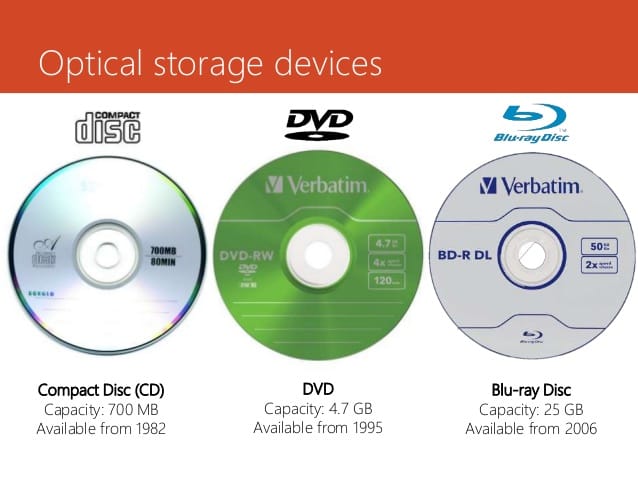An optical disk is a storage medium that uses laser technology to read and write data. Unlike magnetic disks (e.g., HDDs), optical disks store data in pits and lands on a reflective surface, which are interpreted by a laser beam.

Key Components of an Optical Disk
- Polycarbonate Layer – A clear plastic substrate that protects the data layer.
- Reflective Layer – Usually aluminum or gold, reflects the laser beam.
- Data Layer – Contains pits (indentations) and lands (flat areas) encoding binary data.
- Protective Layer – A coating (e.g., lacquer) to prevent scratches.
Types of Optical Disks
| Type | Capacity | Usage |
|---|---|---|
| CD | 700 MB | Music, software, small backups |
| DVD | 4.7–17 GB | Movies, larger data storage |
| Blu-ray | 25–128 GB | HD video, gaming, large backups |
| Ultra HD Blu-ray | 50–100 GB | 4K/8K movies |
Variants by Function:
- ROM (Read-Only Memory) – Pre-recorded (e.g., commercial movies).
- R (Recordable) – Write once (e.g., burning a DVD).
- RW/RE (Rewritable) – Can be erased and rewritten multiple times.
How Optical Disks Work
- Reading Data: A laser shines on the disk, and a sensor detects reflected light.
- Pits scatter light (read as 0).
- Lands reflect light (read as 1).
- Writing Data (for recordable disks): A high-power laser burns pits into a dye layer (CD-R/DVD-R) or changes the phase of a special alloy (DVD-RW/Blu-ray RE).
Advantages & Disadvantages
✔ Advantages:
- Portable & durable (no moving parts, resistant to magnets).
- Cheap for mass distribution (e.g., software, movies).
- Long shelf life (properly stored disks last decades).
✖ Disadvantages:
- Slower than SSDs and HDDs.
- Limited capacity compared to modern storage.
- Susceptible to scratches & degradation (disk rot).
Modern Usage
- Archival storage (long-term backups).
- Media distribution (Blu-ray movies, game discs).
- Legacy systems (some industrial/medical devices still use CDs/DVDs).
